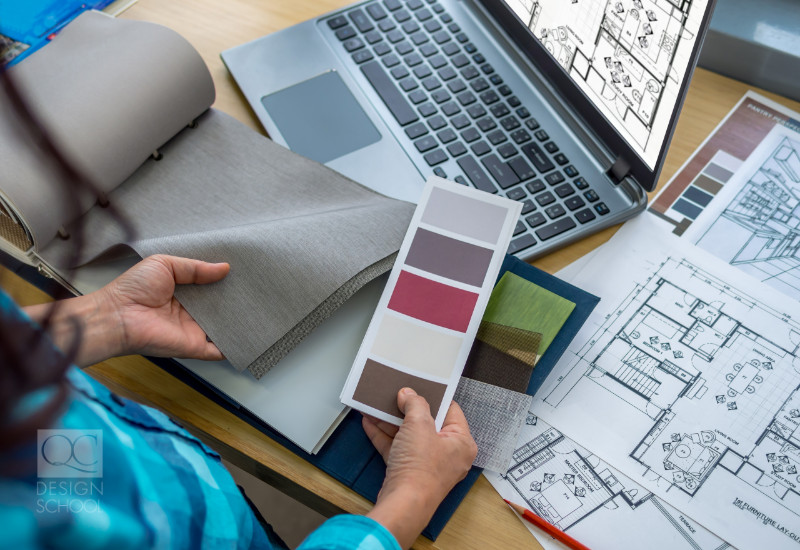Freshly graduated and ready to take on your first professional client? During your interior decorating training, you encountered a variety of different tools necessary to do your job. If it’s been a while since you’ve completed Unit A, here is a quick refresher. Keeping up-to-date on the design tools available to you is key. As your number of clients increase, you’ll have to juggle many different projects at the same time. This means using all the resources you have to stay organized!
When you properly use each of the tools we’re going to discuss, you’ll run an efficient, stress-free business! Ready to proceed? Read on!
Design Profiles
These design profiles are one of the first tools you’ll use when working with a client. The purpose is to seek out the relationship between the client’s interest and lifestyle and match it to the rooms in their home. You also want to outline what sorts of items they already own. Do they match the room’s primary purpose? You wouldn’t put a loveseat in the kitchen, after all!
It’s not enough to get the overarching style of the home. Each room has its own purpose (ex. The kitchen is for cooking), but depending on the specific inhabitants who most often use the room, changes must be made. For instance, a nursery would be decorated differently than the master bedroom.

Site evaluation form
Evaluate the space you’re working with. In order to make changes and improvements, you need to first understand the space. Besides a quick evaluation of the condition of the rooms, you’ll also need to comment on current and proposed materials. The floor, walls, ceiling, doors, windows, closets—be thorough. Since every room in a house could have its own theme, you’ll need to repeat this step for each room.
Floor Plans
You need to draw your own scaled drawings to plan the space and communicate ideas with other professionals and your client. It’s all about translating the space proportionately onto a sheet of paper. It’s a key part of the decorating process! Since you’re hand-drawing your floor plans, you need to be super precise with your ruler. You won’t have the advantage of using virtual programs that automatically snap your lines to a grid!
After marking down the measurements of the space, you’ll include key architectural features. Following that, you’ll create multiple furniture layout options for your client. You may also wish to add color to your drawings.
Presentation Boards
After you’ve done all your research and drawn your floor plans, it’s time for you to present them to your clients. Traditionally, decorators used physical presentation boards. Nowadays, you may wish to use Pinterest boards instead—you’ll be able to include materials and furniture from online retailers along with DIY projects! Whichever type you choose, you should include the same information. You’ll want to have color samples and textile swatches. Examples include window treatments, backsplash tiles, and carpets. After visually seeing everything in one place, your client can properly imagine what their home will look like.

Excel Spreadsheets
Ah, the dreaded spreadsheet. You thought you wouldn’t need it as a decorator, didn’t you? But if you’re taking on large-scale projects for clients who want to stick to their budget, your spreadsheet is your biggest ally! So what should you include? Firstly, your budget estimate should be at the top. When you add in initial estimates, calculate it as a percentage of the overall pie. This way, you can see just how big of a dent your client’s choices are making! Materials, furniture, contractor fees, and your own design fees need a space on the spreadsheet. The best thing about using a spreadsheet application is that you won’t have to do the calculations over and over again. So learn your formulas!
Portfolio
In such a visual profession, you should have a polish professional portfolio to show potential clients. They’ll be able to see for themselves what you’re capable of. Even if you haven’t yet landed your first professional client, all the work that you’ve completed in your training courses can be a great tool to showcase your talent.
Once you graduate, if you really are looking for ways to beef up your portfolio, you can work for a discounted rate. Since you’re a certified decorating professional, you shouldn’t sell yourself short and give services away for free! Start by decorating your own home. If your own home doesn’t radiate creativity, how will you bring an inspired skillset to your client?
Make sure you take plenty of photos. Get a good camera. Or, you can hire a photographer to take professional photos for you. They’ll be able to use the best lighting and angles as well as make basic edits to make your work shine.

Marketing Tools
Especially when you’re just starting out, you’ll need to put in a lot of effort into marketing your services. You haven’t built up your reputation yet so word-of-mouth won’t be enough to carry your business. Besides, you need to create opportunities to show off your portfolio! You’ll need a mix of both physical and digital marketing materials—think both business cards and your own website. You’ll also need an active social media presence. Use these platforms to market your services, connect with current and potential clients, and share helpful resources!
Any other tools we missed? Let us know!
